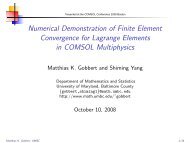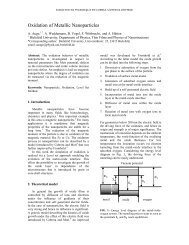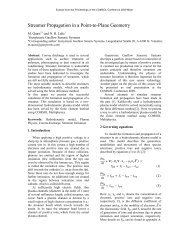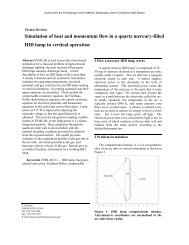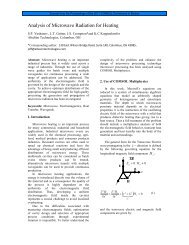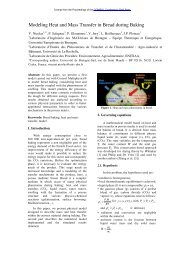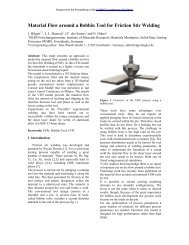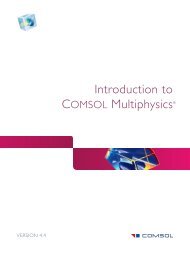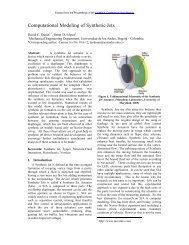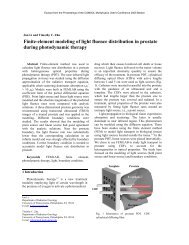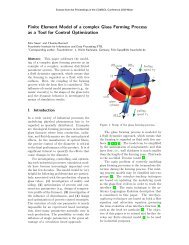Use of COMSOL In Aerodynamic Optimization of the ... - COMSOL.com
Use of COMSOL In Aerodynamic Optimization of the ... - COMSOL.com
Use of COMSOL In Aerodynamic Optimization of the ... - COMSOL.com
Create successful ePaper yourself
Turn your PDF publications into a flip-book with our unique Google optimized e-Paper software.
aerodynamic shape, specifically in reference to<br />
<strong>the</strong> large wetted area associated with <strong>the</strong> fuselage<br />
and its consequent tapering around <strong>the</strong> wing root<br />
to lessen <strong>the</strong> adverse pressure gradients which<br />
may occur o<strong>the</strong>rwise.<br />
<strong>COMSOL</strong> was used to model <strong>the</strong> fluid flow<br />
around <strong>the</strong>se particular parts. As a follow-on<br />
study, structural parameters were input and <strong>the</strong><br />
mechanical behavior <strong>of</strong> <strong>the</strong> airframe <strong>the</strong>n<br />
observed simultaneously. Additionally, we<br />
explored <strong>the</strong> flow field around a twodimensional<br />
airfoil section and <strong>the</strong> effect <strong>of</strong> heat<br />
generation related to <strong>the</strong> solar cells.<br />
2. Problem Formulation<br />
The primary objective <strong>of</strong> winglets is to<br />
reduce overall drag. Originally, endplates were<br />
seen as a way to curb induced drag on real wings<br />
but it wasn’t until much later that winglets came<br />
into <strong>the</strong> form that we can all appreciate today on<br />
modern airliners [15]. There are various schools<br />
<strong>of</strong> thought in wingtip device design and some<br />
devices try to merge <strong>the</strong>se ideas. Planar devices<br />
usually try to ei<strong>the</strong>r capture <strong>the</strong> strength <strong>of</strong> <strong>the</strong><br />
trailing vortices or delay <strong>the</strong>ir creation fur<strong>the</strong>r<br />
outboard. Non-planar devices usually aim to do<br />
<strong>the</strong> same but tend to be more efficient since <strong>the</strong>y<br />
are out <strong>of</strong> <strong>the</strong> wing’s plane.<br />
Winglets have be<strong>com</strong>e an economical way <strong>of</strong><br />
retr<strong>of</strong>itting existing aircraft with a modification<br />
that lessens induced drag and thus reduces <strong>the</strong><br />
power requirements to fly at a particular<br />
airspeed. <strong>In</strong> <strong>the</strong> late 1980’s and early 1990’s,<br />
many would argue that winglets require too<br />
much design work to be effective, especially at<br />
slower speeds [11]. This was in part due to <strong>the</strong><br />
lack <strong>of</strong> <strong>com</strong>puting power and <strong>the</strong> difficulty<br />
involved in optimizing <strong>the</strong>se non-planar lifting<br />
surfaces for more than one flight condition.<br />
Similarly, a balance must be found between <strong>the</strong><br />
reduction in induced drag and <strong>the</strong> increase in<br />
parasitic drag that incurs with respect to <strong>the</strong> new<br />
wetted surfaces. For a fur<strong>the</strong>r discussion on<br />
induced and parasitic drag, please consult [6] and<br />
[14].<br />
Winglets conventionally have a set <strong>of</strong><br />
geometric parameters which can be modified to<br />
achieve desired performance. <strong>In</strong> addition to <strong>the</strong>se<br />
parameters, <strong>the</strong> airfoil used for a winglet will<br />
usually differ from <strong>the</strong> wing’s airfoil selection<br />
since it effectively is implemented for a different<br />
purpose. For a more detailed discussion on <strong>the</strong>se<br />
various parameters and how <strong>the</strong>y may affect <strong>the</strong><br />
results, refer to [8].<br />
The goal <strong>of</strong> this part <strong>of</strong> <strong>the</strong> study was to<br />
minimize <strong>the</strong> drag <strong>of</strong> <strong>the</strong> overall plane in all<br />
flight conditions. Due to <strong>the</strong> size restrictions put<br />
upon <strong>the</strong> project, <strong>the</strong> aspect ratio achieved was<br />
not nearly as high as o<strong>the</strong>r contemporary solar<br />
airplanes. To <strong>com</strong>bat this heightened induced<br />
drag factor and to better span efficiency, <strong>the</strong><br />
incorporation <strong>of</strong> winglets are studied and<br />
developed.<br />
Additionally, winglets usually increase wing<br />
bending moment, especially if <strong>the</strong>y result in a<br />
wingspan increase or if <strong>the</strong>y are non-planar<br />
lifting surfaces. As a result, a structural study<br />
had to be <strong>com</strong>pleted to ensure that <strong>the</strong> desired<br />
fabrication techniques and material selections<br />
were still appropriate.<br />
On an already highly optimized aerodynamic<br />
body, one <strong>of</strong> <strong>the</strong> major drag penalties arise from<br />
junction flow, categorized as interference drag<br />
[11]. Junction flows are highly proprietary in<br />
that <strong>the</strong>y cannot be generalized. Every situation<br />
is simply different, and while broad guidelines<br />
may be outlined, seldom will <strong>the</strong>y be <strong>the</strong><br />
<strong>com</strong>plete answer. For fur<strong>the</strong>r discussion on<br />
juncture flows and three-dimensional boundary<br />
layer interaction, see [12].<br />
Composites have made <strong>com</strong>plex,<br />
aerodynamically advantageous shapes a reality.<br />
As with winglets, increasing <strong>com</strong>puting power<br />
and more accurate fluid flow models have<br />
ramped up interest in <strong>the</strong> analysis and design <strong>of</strong><br />
wing-fuselage flow interaction. See [9] and [5],<br />
for example.<br />
The main objective <strong>of</strong> this part <strong>of</strong> <strong>the</strong> study<br />
was to minimize flow separation, which occurs<br />
at <strong>the</strong> junction and thus lessen <strong>the</strong> overall drag <strong>of</strong><br />
<strong>the</strong> plane. Additionally, <strong>the</strong> overall fuselage<br />
design was modeled to view <strong>the</strong> flow field and<br />
pressure distribution to ensure that laminar flow<br />
was preserved. One major design criterion <strong>of</strong> <strong>the</strong><br />
fuselage is to minimize and separate <strong>the</strong> adverse<br />
pressure gradients. Ano<strong>the</strong>r vital evaluation<br />
criterion is <strong>the</strong> interaction <strong>of</strong> <strong>the</strong> streamlines<br />
from <strong>the</strong> upper and lower halves <strong>of</strong> <strong>the</strong> fuselage,<br />
as well as <strong>the</strong> trailing edge <strong>of</strong> <strong>the</strong> wing. This<br />
evaluation is even fur<strong>the</strong>r <strong>com</strong>plicated, and<br />
generally dictated by, <strong>the</strong> taper <strong>of</strong> <strong>the</strong> fuselage<br />
around <strong>the</strong> airfoil section.<br />
Finally, a side study concerning <strong>the</strong> fluid flow<br />
over a solar-cell coated airfoil section is<br />
presented. <strong>In</strong> this on-going study, <strong>the</strong> flow field<br />
is analyzed for changes over <strong>the</strong> airfoil section as<br />
all three heat transfer modes are active. This<br />
model is currently being built up to accept a<br />
wider range <strong>of</strong> inputs, as discussed in <strong>the</strong> next<br />
section.



